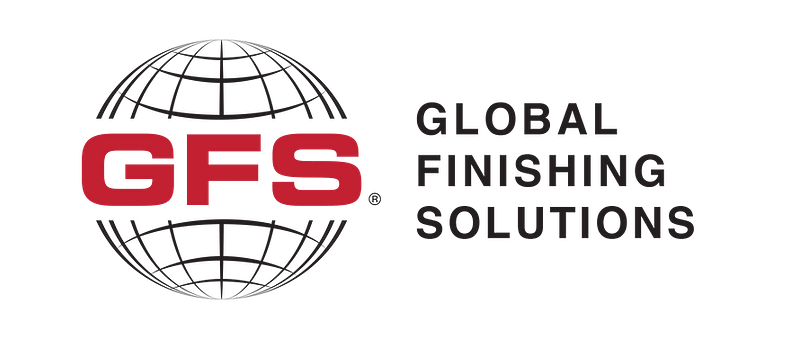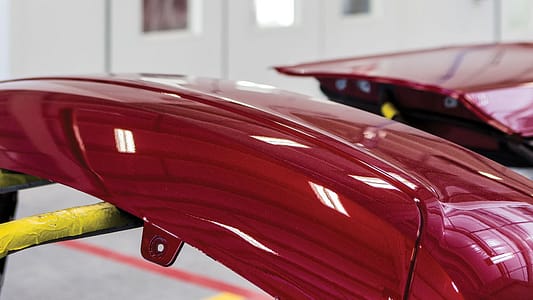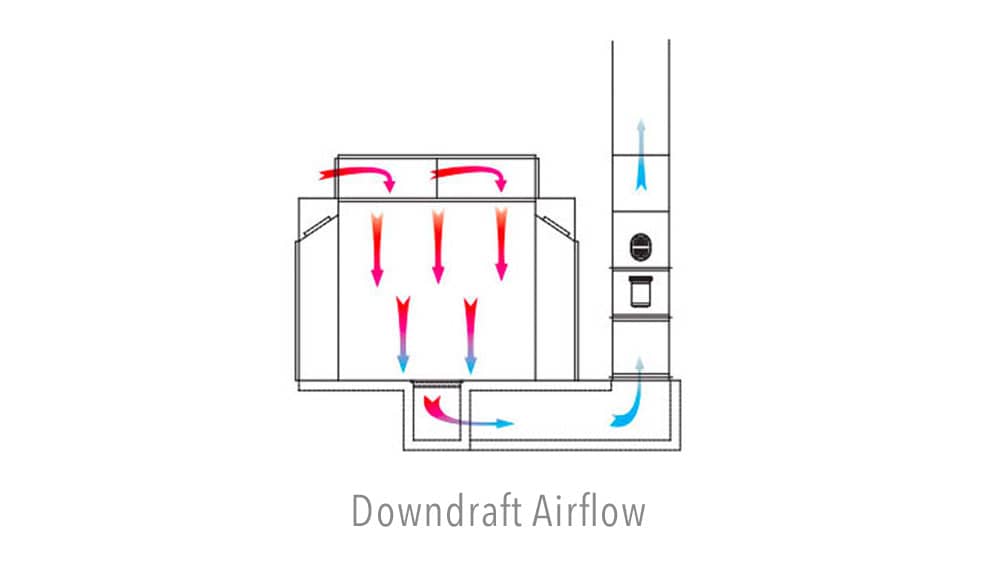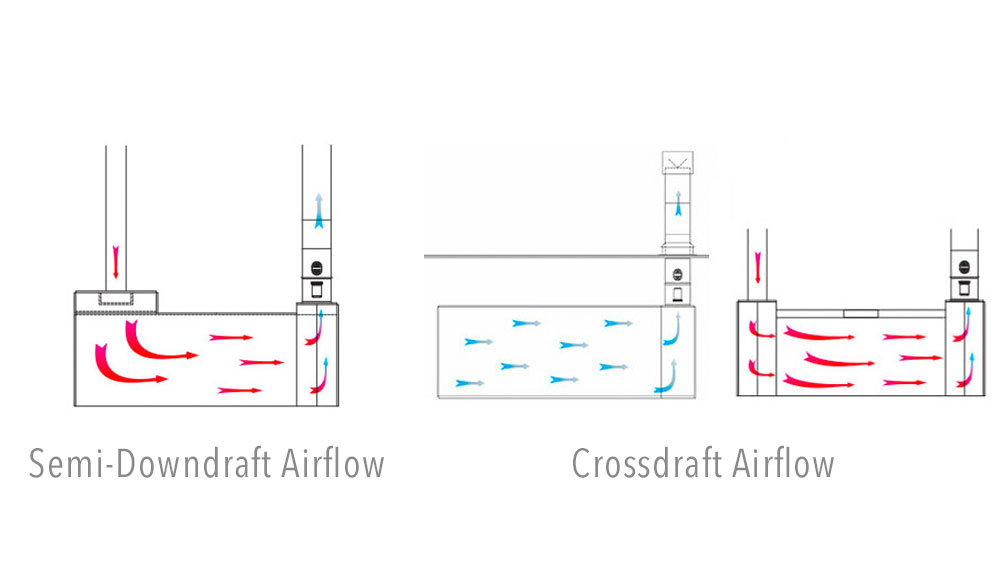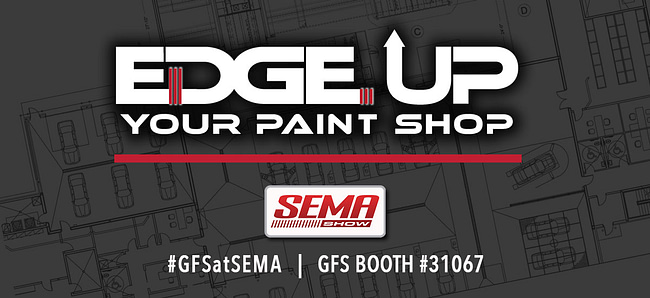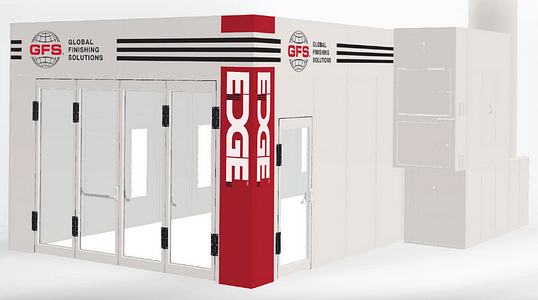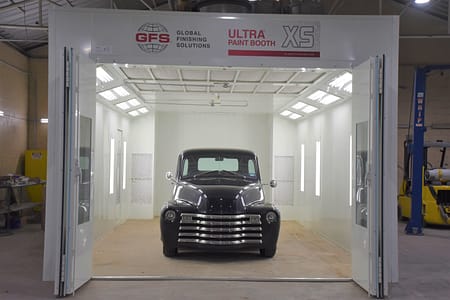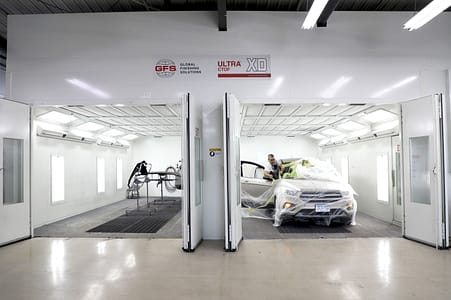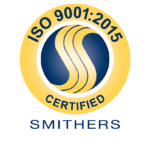When aspiring for a flawless paint finish, it is important to learn about the factors that impact it. Particles as small as 10 microns in size — or about 0.0004 inches — can cause a defect in a paint job. Right down to the nuts and bolts of the equipment, every product you use and everything you do can determine the quality of your paint jobs. To help you pinpoint possible sources of contamination, we have identified nine things to consider in order to achieve high-quality paint finishes:
1. Determine the Best Airflow Style for Your Application
In automotive refinishing applications, pressurized downdraft airflow is the best option to reduce contamination in your paint job. The positive cabin pressure of the booth ensures that no outside contaminants make their way through a leaky seam or seal, and no dirt or dust is pulled into the paint booth when a door is opened. Downdraft airflow effectively controls overspray and contamination by filtering air through a ceiling plenum. From there, air flows vertically over the product and into a filtered exhaust pit in the floor.
If you are working in a paint booth with semi-downdraft or crossdraft airflow, paint overspray from the front half of the booth has the possibility of spreading over everything else. The larger the equipment, more issues may arise as you work your way back in the spray booth. If you are painting something large, like a truck, downdraft airflow effectively captures overspray and does not allow overspray to build upon the trail side of the air.
Downdraft paint booths are heralded as the best airflow for painting items such as cars, trucks, buses, railcars, farm equipment, etc. — anything that does not require the bottom to be painted. When it comes to products that do require the underside to be painted — such as planes — crossdraft booths will typically be the ticket. Painting the underside of an aircraft or other objects can pose a challenge, as it places the painter between the paint gun and the floor. Crossdraft airflow helps by moving overspray away from the painter and toward the exhaust filters.
2. Set up Mixing Operations in a Controlled Area
Once you have selected the best airflow style for your paint booth, it is important to take your painting process into consideration. Having a controlled area for mixing paint — one that is not in or near your paint application area — is key.
Setting up mixing operations — tables, paint cans, spray guns, towels, rags, hoses, etc. — inside of a paint booth is not only breaking code but could present an increased risk for contamination. When items sit in the spray booth, they begin to collect overspray and dust, which can contaminate your paint jobs and create a potential fire hazard.
Paint Mix Rooms from Global Finishing Solutions (GFS) provide a controlled area for safely mixing paint away from painting activities. With a built-in ventilation system, air is pulled from outside of the mix room and flows through high-quality filters to remove dust and dirt contaminants. Since fresh air is continuously moving, harmful vapors are forced into the exhaust plenum and away from personnel and the paint booth.
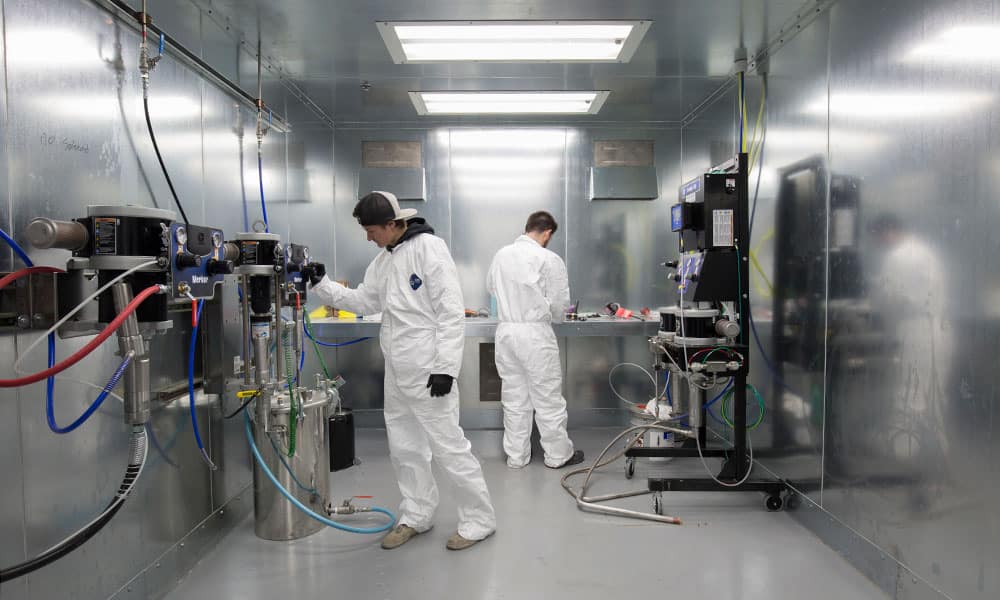
Hazardous Material Storage Buildings — sometimes referred to as “paint kitchens” — are another option to provide a safe, code-compliant environment for storing large amounts of paint and other chemicals. They also double as a safe area for mixing and pumping paint.
3. Wear Protective Attire
Protective clothing for painters plays a simple but important role in both quality and safety. A paint suit should cover the painter’s entire body — from their hands to their feet. Not only does it protect the painter, but this also keeps dirt and other contaminants out of the paint job.
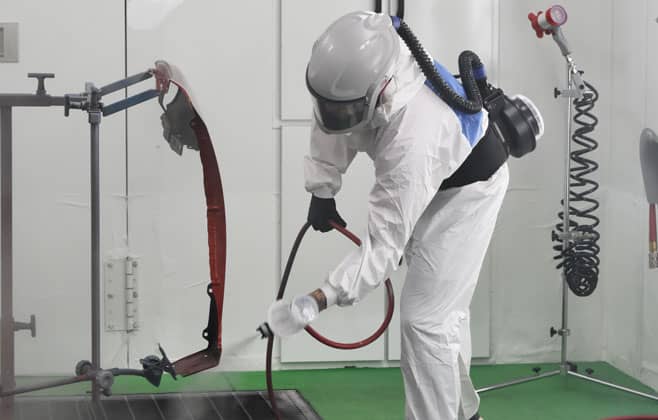
One shop noticed small blue fibers appearing in their paint jobs. Upon evaluation, they realized that a change in their shop processes inadvertently resulted in contamination. They had recently changed their uniforms to blue work shirts, which they wore (without a paint suit) while painting. They discovered that these new shirts were pilling and the fibers were landing in the paint jobs.
The right paint suit can save you months of rework by preventing contamination from occurring in the first place.
4. Clean Surfaces Before Spraying
Before spraying, wipe down all surfaces with a microfiber cloth. This is especially important in Open Face Booths since the open working environment makes it easy to pull contaminants in from the shop. If you work outside, or in a shop with open doors, pollen can also be a big issue. By wiping surfaces down while working, you are getting ahead of the contaminants and preventing them from disrupting your paint job.
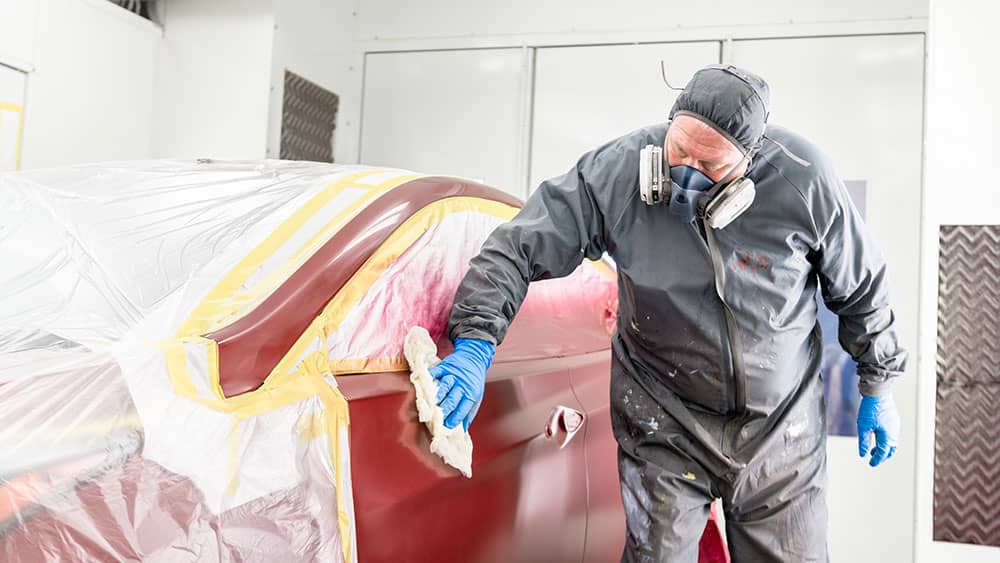
5. Be Conscious of Where You Are Spraying
Painting requires immense concentration and technical expertise. It also differs based on your spray booth’s airflow configuration. As you are spraying, keep in mind where you are in the booth.
If you are painting in a crossdraft or semi-downdraft paint booth, start spraying at the front and work your way toward the back. If you start at the back and move toward the front of the booth, overspray will drift over the top of the paint you just applied. If any dust or dirt enters the spray environment, it will also get caught in the paint.

If you are painting in a downdraft booth, be conscious of what type of product you are painting. When painting aircraft in a downdraft spray booth, overspray is pulled away from the plane and toward the floor filters. As air rolls over the wing and fuselage, overspray can become difficult to control, so it is also best to work high to low.
6. Control Humidity
How to effectively control humidity depends on what type of coating you are spraying and the type of surface you are spraying on. There are many waterborne paints that require low humidity to dry out the air and assist the drying process. It is best to reference the technical data sheet of the coating you are using, which will specify the desired humidity level. There are ways to adjust the paint to react better to that humidity.
If you are spraying waterborne paint, the ideal temperature in your paint booth is 70 to 75 degrees Fahrenheit, or 5 degrees above the ambient temperature in your shop. When the temperature in your heated paint booth is above that ambient temperature, the burner will turn on intermittently to burn out and reduce the humidity level in the booth.
In hot, dry climates like Arizona, painters experience the opposite problem. When it is too dry, misting devices are often used in the intake ductwork to ensure paint does not dry too fast. Solvent-based coatings dry well on their own, regardless of the humidity, and in some cases even dry faster with higher humidity. Regardless, it is good to have a way of monitoring humidity in your paint booth.
7. Choose Cleaners Carefully
The worst damage from contaminants can be caused by silicone entering the painting environment. Often, silicone is an ingredient in the cleaners used in other parts of a shop, especially if there is a detail department. As a best practice, you should always use silicone-free cleaners. Some new cleaners claim to be silicone-free, yet they include an additive that reacts the same way as silicone. Spraying just a small amount of that into a shop can cause fisheyes in your finish. To prevent this problem, keep detail areas completely separate from the paint shop — in a different building or walled off.
8. Change Filters Regularly
One of the simplest things you can do for the cleanliness and overall productivity of your paint booth is changing the intake and exhaust filters on a regular schedule. Intake filters provide clean, filtered air to the booth, protecting your coating operation from foreign particles that can contaminate your paint job. However, you may need to take environmental factors into account when developing your filter change out schedule.
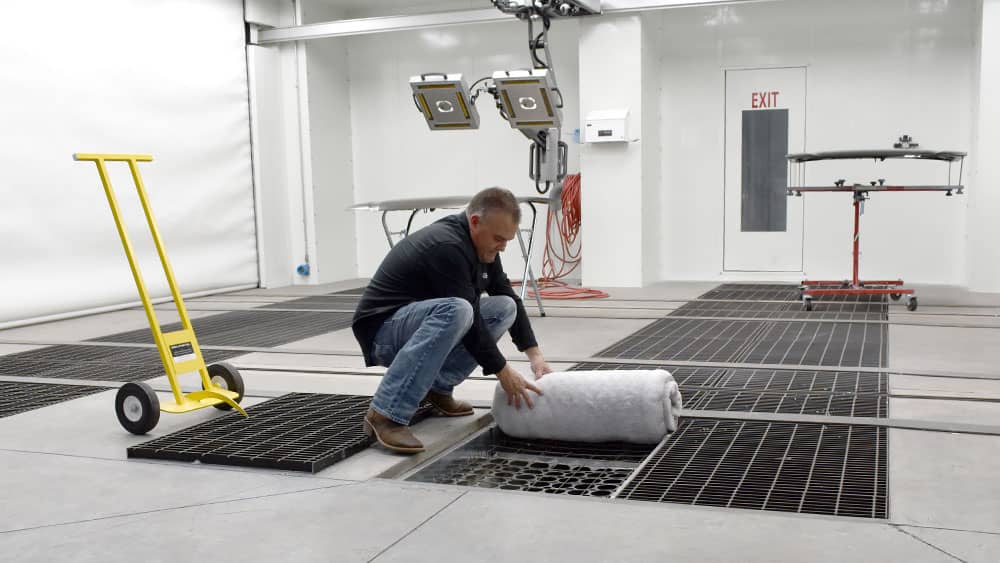
For instance, a shop once had fisheyes in their clear coat, which started around 10:30 a.m. every day. At the same time, the booth started smelling like fried food. When this shop installed their new paint booth, the exhaust stack was placed on the side of the building that faced a KFC. Every day, when KFC started their fryers and exhausted the fumes, the fryer fumes entered the booth’s airflow. If the shop kept the same filters in for more than a month, the fumes saturated through the filters in the paint booth and ended up on the surface of the item they were painting, resulting in fisheyes.
This example could have been avoided by regularly changing the filters.
9. Confine Your Booth to Painting
We often see shops that perform tasks other than painting in their paint booths. These tasks can not only cause contamination issues, but they could become safety issues as well. For instance, buffing or sanding in a paint booth can not only cause sparks and other flammability risks, the particles can also end up in your paint jobs. Another issue that tends to arise is eating food in a paint booth. If you eat food in your paint booth, the food particles will show up in your paint. It is best to do these activities outside of your paint booth to avoid contamination.
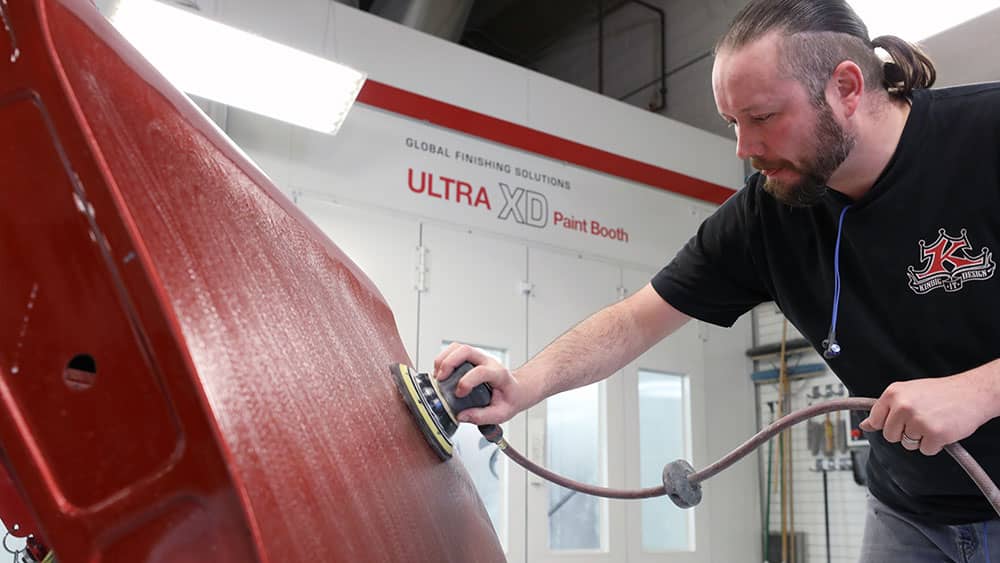
In addition to limiting the tasks in your paint booth, you should also limit the items stored in your booth for any amount of time. Objects that sit in the booth for long periods of time — like a broom or stereo — could build up contaminants and harm your finish quality. Paint booth accessories such as the BoothBox 2™ — a magnetic, double-compartment cabinet and double spray gun holder, designed for the interior of paint booths — and the Rotating Booth Access Table — a rotating turntable that connects to your mix room — will help keep supplies handy while keeping contaminants out of your paint booth and paint jobs.
High-quality finishes not only make products look presentable and unique, but they also play an important role in ensuring products meet performance expectations and last longer. Quality and customer satisfaction go hand-in-hand when considering the final finish. In some high-end industries — such as yachts and custom vehicles — appearance is much more important than in a typical metal fabrication shop. Even the tiniest imperfection of a show vehicle can affect one’s perception of the level of finesse in the finish and the value of the product underneath. From choosing the right equipment to following a regular maintenance schedule, these are steps in the right direction to obtaining — and retaining — flawless finishes.
